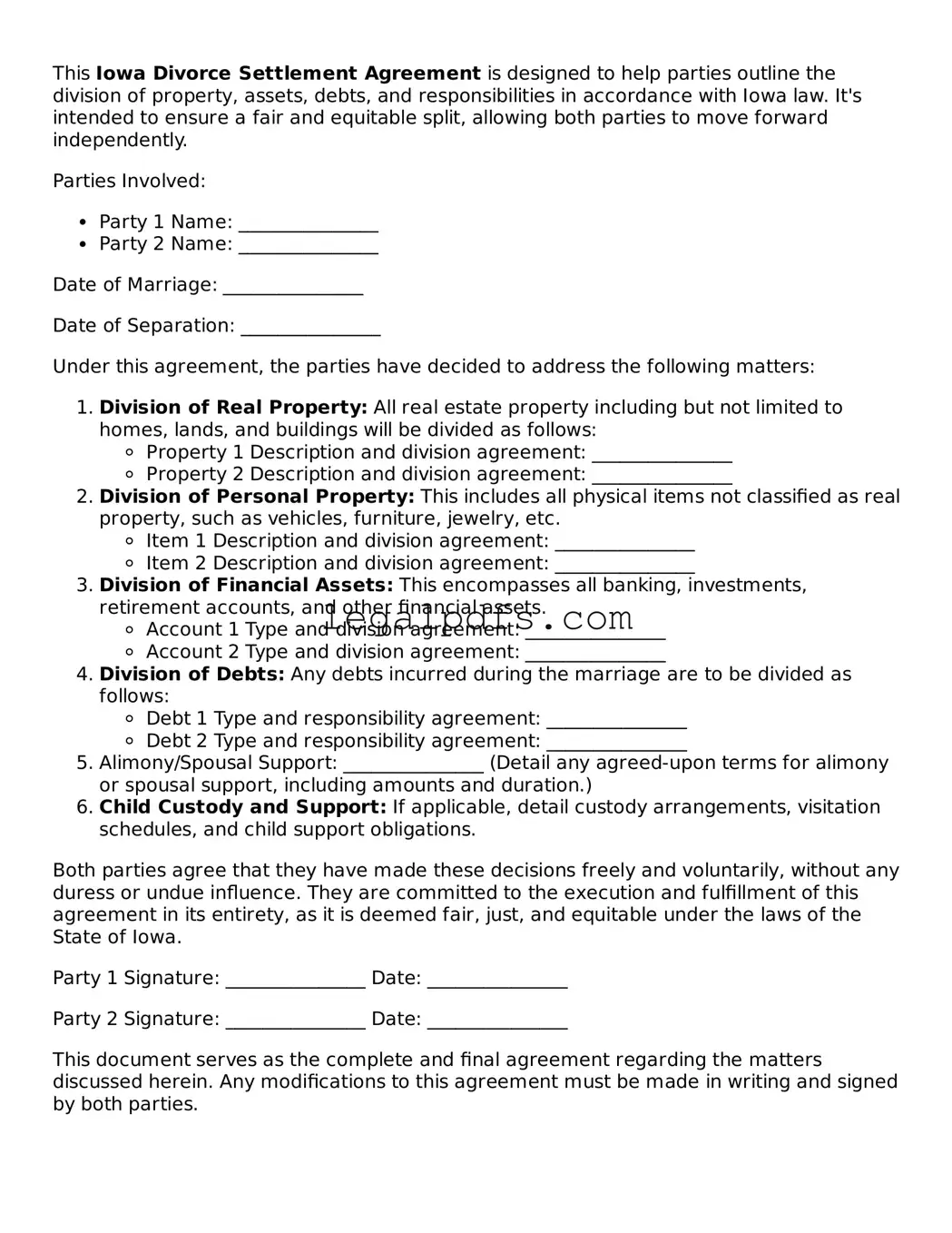What is an Iowa Divorce Settlement Agreement?
An Iowa Divorce Settlement Agreement is a legally binding document that outlines how a divorcing couple has agreed to allocate their assets, debts, custody arrangements (if applicable), and any alimony or child support. This agreement is typically filed in the state of Iowa and must be approved by a court to be deemed legally binding.
Do both parties need to agree to the terms of the Divorce Settlement Agreement?
Yes, both parties must agree to the terms outlined in the Divorce Settlement Agreement for it to be considered valid. This agreement is a mutual understanding of the division of their life together and must be agreed upon before submitting it to the court for approval.
What happens if we cannot agree on the terms of our Divorce Settlement Agreement?
If both parties cannot agree on the terms of the Divorce Settlement Agreement, the case may go to mediation or even a court trial, where a judge will make the final decisions regarding the division of assets, custody, and any financial support. It's often in the best interest of both parties to come to an agreement outside of court to expedite the process and reduce costs.
Is the Divorce Settlement Agreement the same as a divorce decree?
No, a Divorce Settlement Agreement is not the same as a divorce decree. The agreement is a document that outlines the terms of the divorce negotiated between the two parties. A divorce decree is an official order from the court finalizing the divorce and includes the terms outlined in the Divorce Settlement Agreement once it has been approved by the court.
Can we modify our Divorce Settlement Agreement after it has been approved by the court?
Yes, it is possible to modify a Divorce Settlement Agreement after court approval, but both parties must agree to the changes. Additionally, the modifications must be submitted to and approved by the court. Modifications are generally reserved for significant changes in circumstances.
What should be included in an Iowa Divorce Settlement Agreement?
An Iowa Divorce Settlement Agreement should include details about the distribution of all assets and debts, child custody and visitation schedules (if applicable), child support, alimony, and any other matters relevant to the dissolution of the marriage. It should be thorough to prevent future disputes.
How is child support calculated in Iowa?
In Iowa, child support is calculated based on the income of both parents, the number of children, and the custody arrangement. The state provides guidelines and a calculator that can help estimate child support obligations. This calculation should be included and detailed in the Divorce Settlement Agreement if applicable.
Do we need a lawyer to create an Iowa Divorce Settlement Agreement?
While you are not required to have a lawyer to create a Divorce Settlement Agreement in Iowa, it is highly recommended to consult with one. A lawyer can help ensure that the agreement is fair, accurately represents both parties' intentions, and meets all legal requirements. Legal guidance can also help avoid issues that might arise from an improperly drafted agreement.
How is property divided in Iowa during a divorce?
Iowa is an "equitable distribution" state, meaning that marital property will not necessarily be divided equally but rather in a way that is deemed fair by the court. Factors such as the length of the marriage, contributions to the marriage by each spouse, and each party's economic circumstances are considered. These terms should be clearly laid out in the Divorce Settlement Agreement.
What happens if one party violates the Divorce Settlement Agreement?
If one party violates the Divorce Settlement Agreement, the other party can file a motion with the court to enforce the agreement. The court may then order the violating party to comply with the terms of the agreement and potentially face additional legal consequences, such as fines or even jail time for contempt of court.
